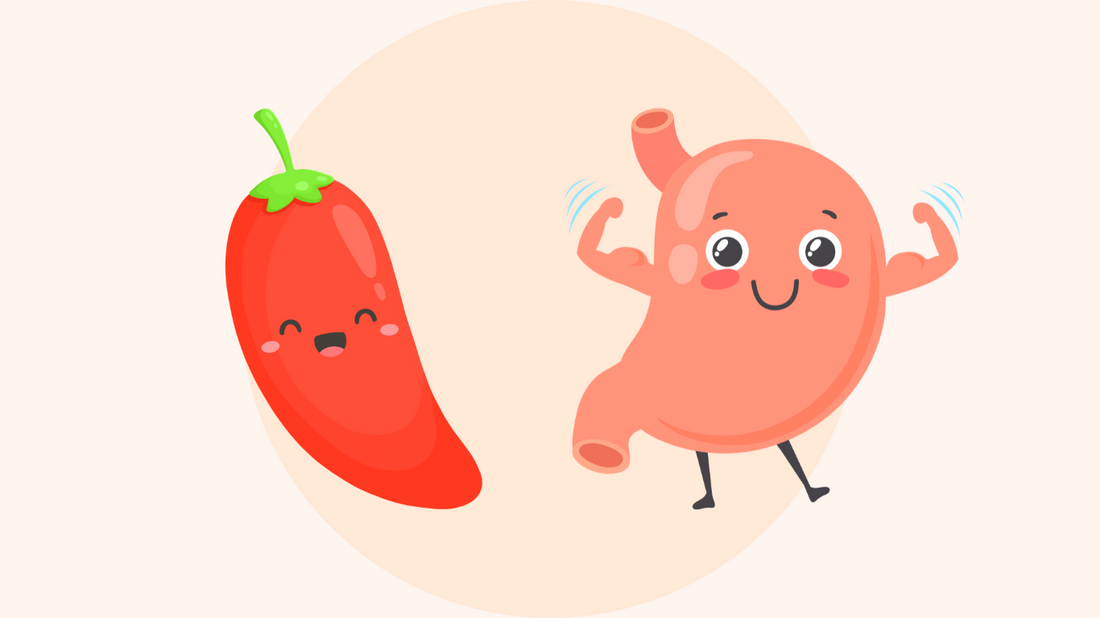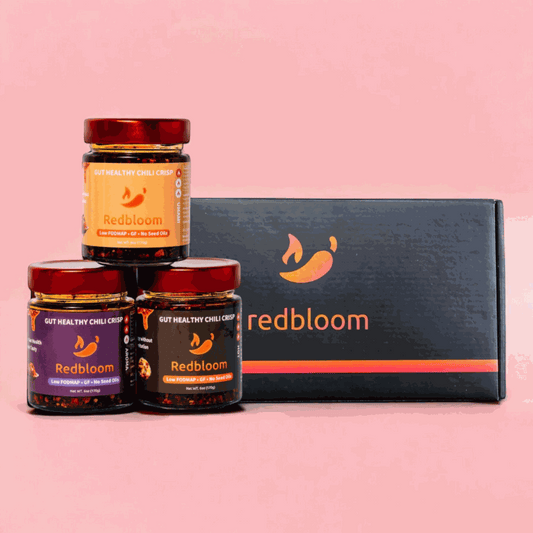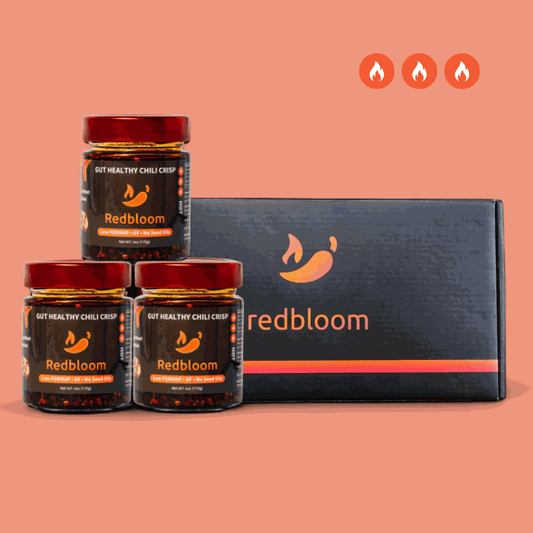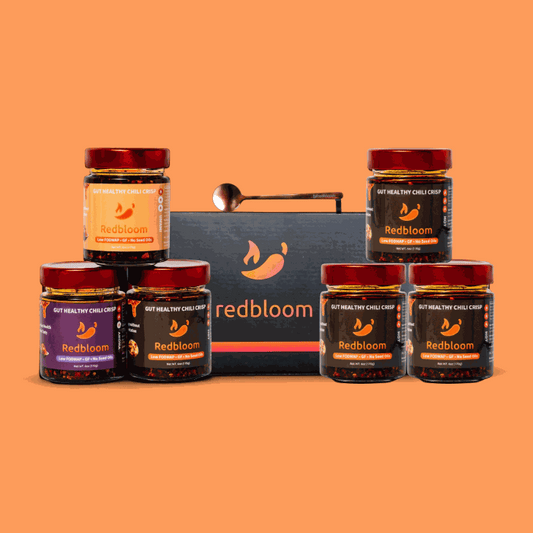Introduction
If your stomach has turned against your favorite spicy foods, whether it’s chili crisp, buffalo wings, or spicy ramen, you’re not alone. Many people who once adored heat find that even a mild kick now leads to bloating, nausea, or burning discomfort.
The good news? Your gut can relearn tolerance. The human digestive system is remarkably adaptive, and with the right approach, you can rebuild your relationship with spice, without suffering through it.
In this guide, we’ll explore the science behind spice sensitivity, how your body can recondition itself to capsaicin, and a practical, step-by-step plan to rekindle your love for heat, gently and safely.
What Actually Happens When You Eat Spicy Food
Capsaicin, the fiery compound that gives chili peppers their punch, activates nerve receptors called TRPV1. These receptors are found throughout your mouth, esophagus, and gut, and they’re responsible for sensing temperature and pain.
When you eat something spicy, TRPV1 sends an urgent message to your brain: “We’re burning!” even though there’s no real damage happening. That’s why your body reacts with watering eyes, a racing heartbeat, and sometimes, stomach cramps or diarrhea [1].
But here’s the fascinating part: your body can adapt. With repeated, controlled exposure, TRPV1 receptors gradually become less sensitive, a process known as desensitization [2].
The Science of Building Tolerance
1. Desensitization of TRPV1 Receptors
With consistent low-level exposure to capsaicin, TRPV1 receptors start to downregulate, which means fewer “burn” signals reach your brain. This makes spicy foods feel milder over time and reduces the intensity of gut reactions [2].
2. Gut Adaptation Takes Time
Your mouth and brain adapt quickly, but your gut is slower to catch up. Gradual exposure over several weeks helps the digestive system recalibrate. Many people find that symptoms like bloating or mild cramping fade as their stomach adjusts [3].
3. Individual Factors Matter
Genetics, gut health history, and even medications influence how your body reacts to spice. Some people naturally have fewer TRPV1 receptors and experience less discomfort; others may need a more cautious approach [4].
What Research, and Real Life, Reveal
A clinical study found that after several weeks of daily capsaicin intake, participants required higher doses to feel the same burn [5].
Meanwhile, populations that regularly consume chili-based diets, like in India, Thailand, or Mexico, often report fewer digestive issues and lower receptor sensitivity overall [2].
Cultural habits also play a role. People who grow up around spice tend to develop early tolerance, while those who eliminate it for long periods often find their sensitivity returns [6].
How to Rebuild Your Spice Tolerance
Phase 1: Ease In
Start with very mild spices, like smoked paprika, banana peppers, or black pepper, and incorporate them into well-balanced meals. Mix a small amount of chili oil or chili crisp into creamy bases like yogurt, soups, or dips to buffer intensity [7].
Tips:
-
Eat spice with food, never on an empty stomach.
-
Combine with healthy fats (avocado, olive oil) to reduce irritation.
-
Keep a food journal to note symptoms and track improvement.
Phase 2: Stay Consistent
The key to desensitization is frequency, not intensity. Add a touch of spice daily, increasing in tiny increments, say, half a teaspoon of chili crisp instead of a quarter. Inconsistent exposure resets your progress [7].
Phase 3: Level Up Mindfully
Once your gut is handling mild heat comfortably, explore dishes like Thai curries, spicy noodles, or tacos made with chili paste. Balance them with cooling ingredients, like cucumber, coconut milk, or yogurt, to keep things gentle.
Pair Spice with Gut-Soothing Foods
Rebuilding tolerance doesn’t mean suffering through every meal. Certain foods can help your gut adapt and calm inflammation.
-
Dairy: Casein in milk and yogurt binds to capsaicin, dulling the burn [8].
-
Starches: Rice, potatoes, and bread absorb capsaicin oils, easing irritation.
-
Hydration: Water helps flush capsaicin, but coconut milk or fruit smoothies coat the stomach more effectively.
Gut-Friendly Habits for Long-Term Success
-
Don’t rush adaptation. A little discomfort is fine; severe cramps are a sign to scale back.
-
Eat balanced meals. Avoid stacking multiple triggers, spice, alcohol, and acid-rich foods together.
-
Prioritize gut rest. Take occasional breaks and focus on soothing meals when needed.
-
Avoid “heat challenges.” Overexposure can inflame the gut lining and undo progress [2].
When to Be Cautious
If you’ve been diagnosed with IBS, GERD, ulcers, or IBD, talk to your gastroenterologist before reintroducing spice. Even moderate capsaicin can worsen inflammation for some individuals [4].
FAQs
1. How long does it take to rebuild tolerance?
Most people notice improvement within 2–6 weeks of gradual, consistent exposure.
2. Can spicy food permanently damage the gut?
Not in moderation, but overconsumption can temporarily irritate the stomach lining and cause cramping.
3. Is chili oil more intense than fresh peppers?
Yes. Because capsaicin dissolves in fat, chili oil delivers a stronger, more concentrated sensation.
4. Do probiotics help during this process?
They can. A balanced microbiome supports digestion and reduces inflammatory reactions to spice.
5. What if my tolerance doesn’t return?
Everyone has a unique threshold. If your body remains sensitive, it’s okay, honor your limits and enjoy spice at a level that keeps your gut happy.
Conclusion
You can absolutely retrain your gut to handle spice again. The process takes patience, self-awareness, and steady exposure, but the reward is worth it.
With smart food pairing, mindful eating, and respect for your body’s pace, even the most sensitive stomach can rediscover the joy of a little heat. So start small, listen to your gut, and remember: tolerance grows one bite at a time.





